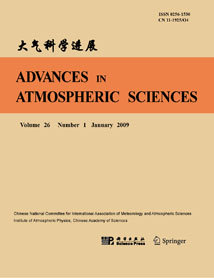| [1] |
Xiuzhen LI, Wen ZHOU, Yongqin David CHEN,
2016: Detecting the Origins of Moisture over Southeast China: Seasonal Variation and Heavy Rainfall, ADVANCES IN ATMOSPHERIC SCIENCES, 33, 319-329.
doi: 10.1007/s00376-015-4197-5
|
| [2] |
DONG Haiping, ZHAO Sixiong, ZENG Qingcun,
2007: A Study of Influencing Systems and Moisture Budget in a Heavy Rainfall in Low Latitude Plateau in China during Early Summer, ADVANCES IN ATMOSPHERIC SCIENCES, 24, 485-502.
doi: 10.1007/s00376-007-0485-z
|
| [3] |
LU Riyu*, DONG Huilin, SU Qin, and Hui DING,
2014: The 30-60-day Intraseasonal Oscillations over the Subtropical Western North Pacific during the Summer of 1998, ADVANCES IN ATMOSPHERIC SCIENCES, 31, 1-7.
doi: 10.1007/s00376-013-3019-x
|
| [4] |
ZHAI Guoqing, LI Xiaofan, ZHU Peijun, SHEN Hangfeng, ZHANG Yuanzhi,
2014: Surface Rainfall and Cloud Budgets Associated with Mei-yu Torrential Rainfall over Eastern China during June 2011, ADVANCES IN ATMOSPHERIC SCIENCES, 31, 1435-1444.
doi: 10.1007/s00376-014-3256-7
|
| [5] |
ZHOU Lingli, DU Huiliang, ZHAI Guoqing, WANG Donghai,
2013: Numerical Simulation of the Sudden Rainstorm Associated with the Remnants of Typhoon Meranti (2010), ADVANCES IN ATMOSPHERIC SCIENCES, 30, 1353-1372.
doi: 10.1007/s00376-012-2127-3
|
| [6] |
Wenshou TIAN, GUO Zhenhai, YU Rucong,
2004: Treatment of LBCs in 2D Simulation of Convection over Hills, ADVANCES IN ATMOSPHERIC SCIENCES, 21, 573-586.
doi: 10.1007/BF02915725
|
| [7] |
Ren Baohua, Huang Ronghui,
2002: 10-25-Day Intraseasonal Variations of Convection and Circulation Associated with Thermal State of the Western Pacific Warm Pool during Boreal Summer, ADVANCES IN ATMOSPHERIC SCIENCES, 19, 321-336.
doi: 10.1007/s00376-002-0025-9
|
| [8] |
REN Baohua, HUANG Ronghui,
2003: 30-60-day Oscillations of Convection and Circulation Associated with the Thermal State of the Western Pacific Warm Pool during Boreal Summer, ADVANCES IN ATMOSPHERIC SCIENCES, 20, 781-793.
doi: 10.1007/BF02915403
|
| [9] |
Iman ROUSTA, Mehdi DOOSTKAMIAN, Esmaeil HAGHIGHI, Hamid Reza GHAFARIAN MALAMIRI, Parvane YARAHMADI,
2017: Analysis of Spatial Autocorrelation Patterns of Heavy and Super-Heavy Rainfall in Iran, ADVANCES IN ATMOSPHERIC SCIENCES, 34, 1069-1081.
doi: 10.1007/s00376-017-6227-y
|
| [10] |
Chang-Kyun PARK, Minhee CHANG, Chang-Hoi HO, Kyung-Ja HA, Jinwon KIM, Byung-Ju SOHN,
2021: Two Types of Diurnal Variations in Heavy Rainfall during July over Korea, ADVANCES IN ATMOSPHERIC SCIENCES, 38, 2201-2211.
doi: 10.1007/s00376-021-1178-8
|
| [11] |
WANG Shuzhou, YU Entao, WANG Huijun,
2012: A Simulation Study of a Heavy Rainfall Process over the Yangtze River Valley Using the Two-Way Nesting Approach, ADVANCES IN ATMOSPHERIC SCIENCES, 29, 731-743.
doi: 10.1007/s00376-012-1176-y
|
| [12] |
WU Liji, HUANG Ronghui, HE Haiyan, SHAO Yaping, WEN Zhiping,
2010: Synoptic Characteristics of Heavy Rainfall Events in Pre-monsoon Season in South China, ADVANCES IN ATMOSPHERIC SCIENCES, 27, 315-327.
doi: 10.1007/s00376-009-8219-z
|
| [13] |
Huizhen YU, Zhiyong MENG,
2022: The Impact of Moist Physics on the Sensitive Area Identification for Heavy Rainfall Associated Weather Systems, ADVANCES IN ATMOSPHERIC SCIENCES, 39, 684-696.
doi: 10.1007/s00376-021-0278-9
|
| [14] |
Ui-Yong BYUN, Jinkyu HONG, Song-You HONG, Hyeyum Hailey SHIN,
2015: Numerical Simulations of Heavy Rainfall over Central Korea on 21 September 2010 Using the WRF Model, ADVANCES IN ATMOSPHERIC SCIENCES, 32, 855-869.
doi: 10.1007/s00376-014-4075-6
|
| [15] |
HOU Tuanjie, Fanyou KONG, CHEN Xunlai, LEI Hengchi, HU Zhaoxia,
2015: Evaluation of Radar and Automatic Weather Station Data Assimilation for a Heavy Rainfall Event in Southern China, ADVANCES IN ATMOSPHERIC SCIENCES, 32, 967-978.
doi: 10.1007/s00376-014-4155-7
|
| [16] |
Rudi XIA, Yali LUO, Da-Lin ZHANG, Mingxin LI, Xinghua BAO, Jisong SUN,
2021: On the Diurnal Cycle of Heavy Rainfall over the Sichuan Basin during 10–18 August 2020, ADVANCES IN ATMOSPHERIC SCIENCES, 38, 2183-2200.
doi: 10.1007/s00376-021-1118-7
|
| [17] |
Angkool WANGWONGCHAI, ZHAO Sixiong, ZENG Qingcun,
2005: A Case Study on a Strong Tropical Disturbance and Record Heavy Rainfall in Hat Yai, Thailand during the Winter Monsoon, ADVANCES IN ATMOSPHERIC SCIENCES, 22, 436-450.
doi: 10.1007/BF02918757
|
| [18] |
Seung-Woo LEE, Dong-Kyou LEE, Dong-Eon CHANG,
2011: Impact of Horizontal Resolution and Cumulus Parameterization Scheme on the Simulation of Heavy Rainfall Events over the Korean Peninsula, ADVANCES IN ATMOSPHERIC SCIENCES, 28, 1-15.
doi: 10.1007/s00376-010-9217-x
|
| [19] |
Ji-Hyun HA, Hyung-Woo KIM, Dong-Kyou LEE,
2011: Observation and Numerical Simulations with Radar and Surface Data Assimilation for Heavy Rainfall over Central Korea, ADVANCES IN ATMOSPHERIC SCIENCES, 28, 573-590.
doi: 10.1007/s00376-010-0035-y
|
| [20] |
Jeong-Gyun PARK, Dong-Kyou LEE,
2011: Evaluation of Heavy Rainfall Model Forecasts over the Korean Peninsula Using Different Physical Parameterization Schemes and Horizontal Resolution, ADVANCES IN ATMOSPHERIC SCIENCES, 28, 1233-1245.
doi: 10.1007/s00376-011-0058-z
|















 AAS Website
AAS Website 
 AAS WeChat
AAS WeChat 
 DownLoad:
DownLoad: